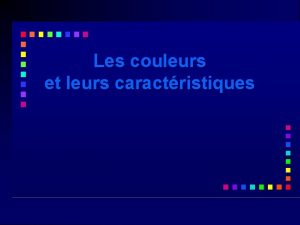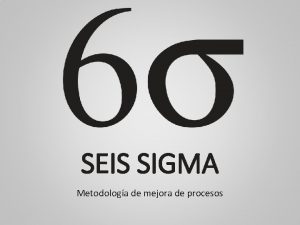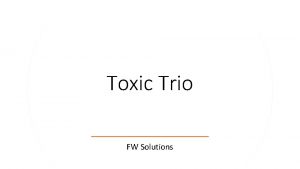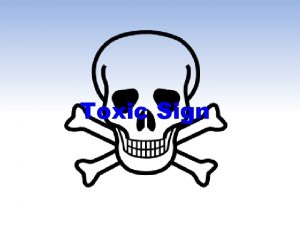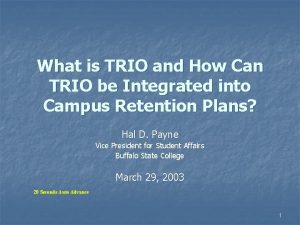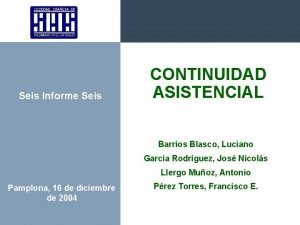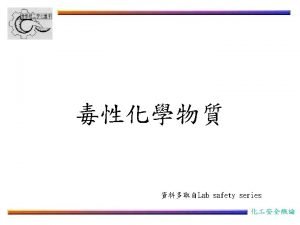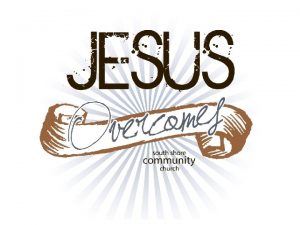Toxic Trio Clair Mc Neill SEIS Louise Pinnock























- Slides: 23

Toxic Trio Clair Mc. Neill - SEIS Louise Pinnock Engage

What is the toxic trio? • Mental Health • Substance Misuse • Domestic Abuse

In Groups Take one of the trio. In your group discuss the effects on children and young people, if one of the toxic trio is present in a family. Jot down some of the effects and how they manifest themselves in school.

Scale of the problem • 250 -350 000 children affected by parental drug use in UK (Hidden Harm) • At least 120 00 children living with a parent currently in treatment • 6% (700 000) live with a dependent drinker • 100 children a week call Childline worried about their parents’ drinking • Serious Case Reviews: 22% drug use, 22% alcohol use

Challenges and vulnerabilities • • Neglect Disruption of household routines Inadequate supervision Physical and emotional abuse Impaired or inappropriate parenting practices Poverty Exposure to drugs and drug-taking equipment in the home • Domestic violence.

Additional impacts • Love and loyalty - being protective of parents • Reluctance to disclose problems at home, and uncertainty of who to talk to • Psychological distress • Fear of intervention by ‘officials’ • Guilt, shame, and stigma • Sadness, isolation, and depression • Anger and frustration • Fear and anxiety (for their parents’ safety, or that they will ‘end up the same’).

Possible indicators • Isolation – finding it hard to socialise, make friends or invite them home • Difficulties completing homework on time • Bullying (including due to poor physical appearance) • Poor attendance or late arrival • Tiredness or lack of concentration • Lack of engagement or interest from parents (e. g. nonattendance at parents’ evenings) • Unavailability for school clubs or trips • Academic underachievement • Behavioural difficulties

Children affected by parental substance use value reassurance that: • they’re not alone • they aren’t to blame • they’re not betraying anybody by talking about it.

They may also benefit from: • • somewhere quiet to relax extra support with school work identified special teachers to talk to knowing other children whose parents use drugs/alcohol • school nurses to check they’re OK, do home visits, and meet their family • access to existing programmes like breakfast/after school clubs, careers advice, and extra-curricular activities.

DSL Handbook Safeguarding pathways. Who is out there to support? What information is there? Up to date information, websites and phone numbers?

DA in Solihull • 4, 846 women expected to experience DA per year • Accounts for 8% of recorded crime and only 39% of incidents are thought to be reported to the police • May – Oct 2014 – 838 children managed via EHMAP • DA is a factor in 38% of social work assessments, and over half of CP plan • A quarter of girls and 18 per cent of boys reported some form of physical partner violence.

Assessing Risk

DASH – Domestic Abuse Stalking & Honour Based Violence DVRIM- Domestic Abuse Risk Identification Matrix

DASH High risk – referral to MARAC Medium/Standard – signpost to specialist support SAFETY PLAN ALWAYS

DVRIM • Evidence of domestic abuse • Risk factors/potential vulnerabilities • Protective factors

• Scale one – moderate – Single agency • Scale two – moderate to serious – CAF/family support intervention • Scale three – serious risk – Child in Need – consider safeguarding S 17 • Scale four – Sever risk – Safeguarding S 47

Domestic abuse • • Triage process Police referrals Meeting daily Education screen cases – with consent Feedback outcomes

Screening tools • DV RIM - children • CAADA DASH – adults (victim)

Case Study Groups of 4 • Label A, B, C, D • Read your information out to the group, decide what level on the threshold document you feel this case is. • Repeat for each new piece of information. • When all 4 have been shared at what level do you feel this is now? • What will your action be?

Solihull Multi-Agency Thresholds Criteria • • Threshold 1 Threshold 2 Threshold 3 Threshold 4 20

Social Work assessment - NFA Case is de-escalated back to early help. So what does this mean? How will you support this family? What can you expect from early help

Comments Concerns Questions

Thank you
 Toxic trio nspcc
Toxic trio nspcc Simon pinnock
Simon pinnock Roy pinnock dentons
Roy pinnock dentons Acte clair
Acte clair Lena st. clair
Lena st. clair French song au clair de la lune lyrics
French song au clair de la lune lyrics Nolan brett
Nolan brett Couleur rabattue
Couleur rabattue Clic clac quel est ce bruit de clochette
Clic clac quel est ce bruit de clochette St clair curve
St clair curve Acte clair and acte eclaire
Acte clair and acte eclaire St clair county intergovernmental grants department
St clair county intergovernmental grants department Contraste en soi
Contraste en soi Lena st. clair
Lena st. clair Author
Author When was claude debussy born
When was claude debussy born Test de crémage
Test de crémage Jorge martn
Jorge martn El quintuple del exceso de un numero sobre 20
El quintuple del exceso de un numero sobre 20 Uno dos tres cuatro cinco
Uno dos tres cuatro cinco Lluvia de ideas seis sigma
Lluvia de ideas seis sigma Seis sombreros
Seis sombreros Palabras con triptongo
Palabras con triptongo Sombreros de colores significado
Sombreros de colores significado







